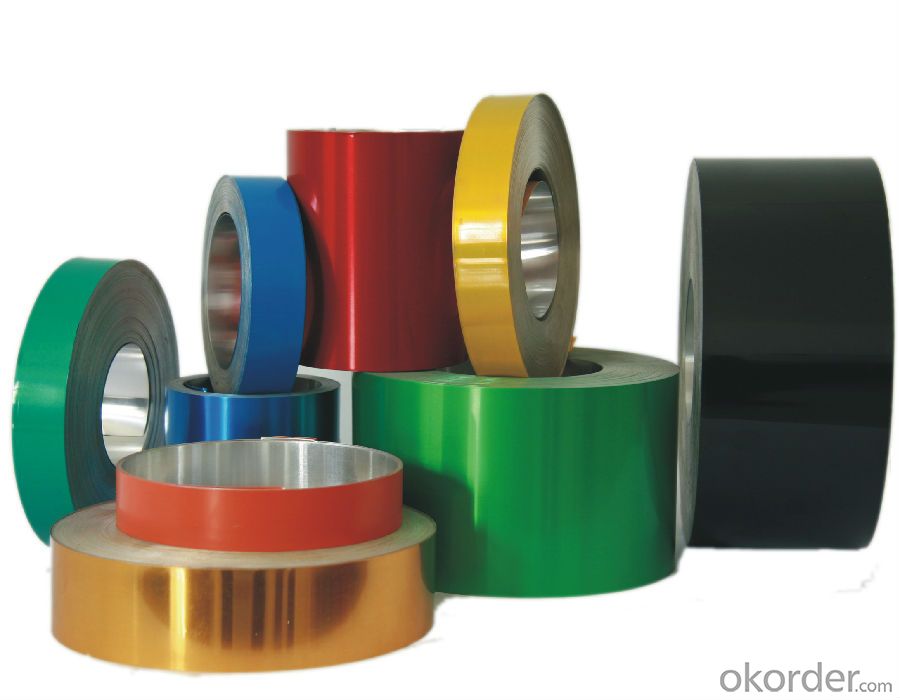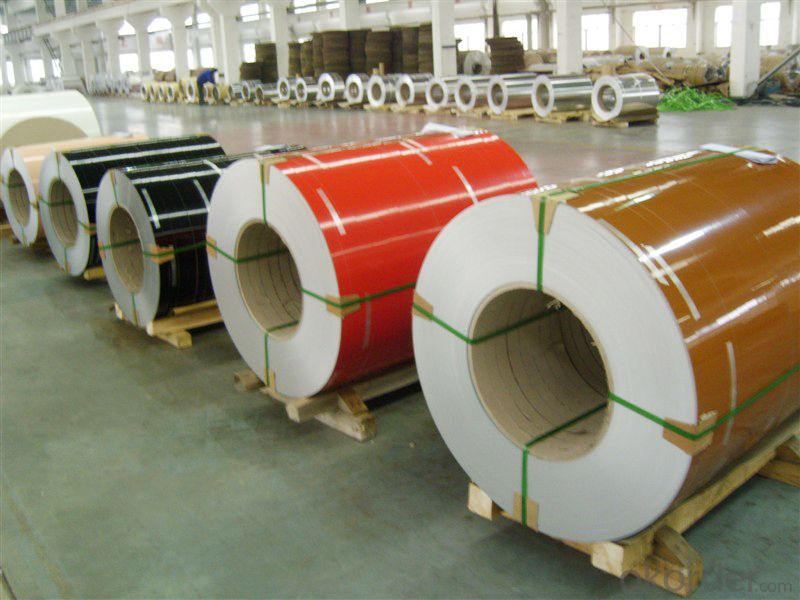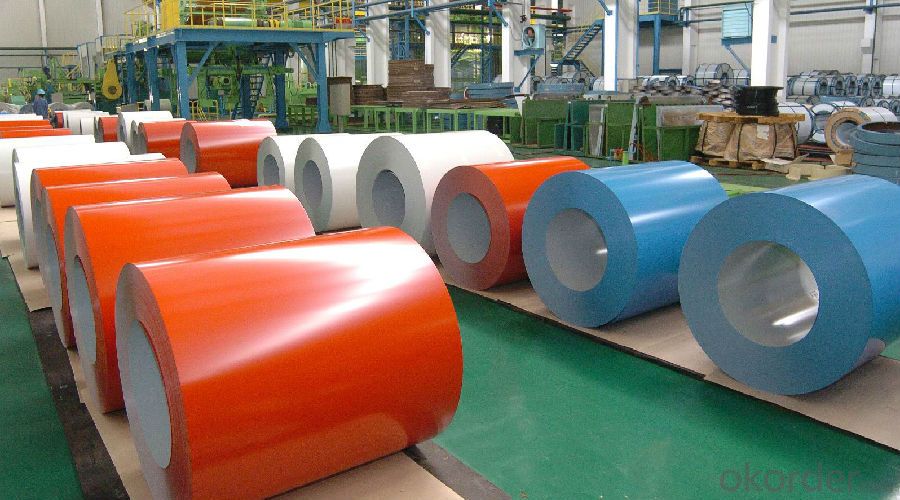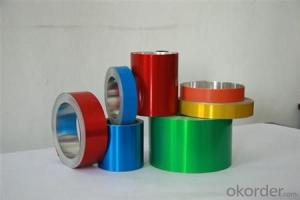Aluminium Pre-painted PVDF Hot Demanded Coil
- Loading Port:
- Shanghai
- Payment Terms:
- TT OR LC
- Min Order Qty:
- 8 m.t.
- Supply Capability:
- 2000 m.t./month
OKorder Service Pledge
OKorder Financial Service
You Might Also Like
Item specifice
Structure of Aluminium Pre-painted PVDF Hot Demanded Coil Description:
Coated aluminum coil/sheet are of a wide range of colors, which gives wonderful appearance no matter in residential and commercial constructions of great exhibition centers.
The coated aluminum coil/sheet have been widely used in the fields of construction and decoration( garage doors, ceiling etc.), electronic appliances, lighting decoration, air-condition air pipes, sandwich panels and drainages etc.
Main Features of the Aluminium Pre-painted PVDF Hot Demanded Coil:
1) High flexibility
2) Impact resistance
3) Excellent weather-proof durability
4) Anti-ultraviolet
5) High erosion resist
Images of the Aluminium Pre-painted PVDF Hot Demanded Coil:



Aluminium Pre-painted PVDF Hot Demanded Coil Specification:
Alloy | A1100,A3003,A1050,A8011 etc |
Temper | H16,H18,H24 |
Thickness | From 0.024mm to 1.2mm |
Width | Standard width:1240mm |
Special width:1300mm,1520mm,1570mm,1595mm | |
Diameter | Standard dia:1200mm |
Interior dia:150mm,405mm,505mm | |
Weight | 2.5 T/coil,3.0 T/coil |
Coating | PE, PVDF, AC |
Surface | Embossed, mill finish, coated |
Color | AS to code RAL |
Gloss | 10-90%(EN ISO-2813:1994) |
Coating Thickness | PE: more than 18 micron |
PVDF: more than 25 micron | |
Coating Hardness (pencil resistance) | More than 2h |
Coating adhesion | 5J(EN ISO-2409:1994) |
Impact Resistance | No peeling or cracking(50 kg/cm,ASTMD-2794:1993) |
Flexibility (T-bend) | 2T |
MEK resistance | More than 100 |
FAQ Aluminium Pre-painted PVDF Hot Demanded Coil:
a.What is monthly capacity
---CNBM is one stated own company and our monthly capacity is about 2000tons.
b. Now which countries do you export your goods?
---Now we export to South East Asia,Africa, North America,South America ect.
- Q:What is the creep resistance of aluminum coils?
- The creep resistance of aluminum coils is generally high, as aluminum has a low melting point and exhibits minimal creep deformation under normal operating conditions.
- Q:Are there any restrictions on the coil surface quality of aluminum coils?
- Yes, there are restrictions on the coil surface quality of aluminum coils. The surface quality of aluminum coils is important for various applications, including aesthetics and functionality. Common restrictions include limitations on surface defects such as scratches, pits, and stains, as well as restrictions on the presence of oil, grease, or other contaminants. These restrictions ensure that the aluminum coils meet the required quality standards and can be used effectively in different industries.
- Q:What are the different types of surface coatings for aluminum coils?
- There are several different types of surface coatings that can be applied to aluminum coils. These coatings serve to protect the aluminum from corrosion, enhance its appearance, and improve its durability. Some of the common types of surface coatings for aluminum coils include: 1. Polyester: Polyester coatings are popular for their excellent color retention and resistance to fading. They provide a smooth, glossy finish and are commonly used for architectural applications. 2. Polyvinylidene Fluoride (PVDF): PVDF coatings offer exceptional weather resistance and durability. They are highly resistant to UV radiation, chemicals, and abrasion, making them suitable for outdoor applications and environments with harsh conditions. 3. Epoxy: Epoxy coatings provide good chemical resistance and adhesion. They are often used in industrial settings where corrosion protection is crucial, such as in chemical processing plants and marine applications. 4. Polyurethane: Polyurethane coatings are known for their durability and resistance to abrasion. They are commonly used in high-traffic areas or applications where the aluminum surface may be subjected to frequent contact or wear. 5. Acrylic: Acrylic coatings offer good weather resistance and color retention. They provide a smooth, glossy finish and are commonly used in architectural and decorative applications. 6. Plastisol: Plastisol coatings are a type of vinyl coating that provides excellent corrosion resistance and flexibility. They are often used in applications where the aluminum surface needs to withstand bending or forming without cracking or peeling. It is important to note that each type of coating has its own unique properties and advantages, and the choice of coating will depend on the specific requirements of the application, such as the level of corrosion resistance, aesthetic preferences, and environmental conditions.
- Q:What is the maximum yield strength of aluminum coils?
- The maximum yield strength of aluminum coils can vary depending on the specific alloy and temper, but it typically ranges between 15,000 and 50,000 pounds per square inch (psi).
- Q:Dongying power plant with 0.6mm thick insulation aluminum coil, manufacturers can be divided into small volumes?
- Tolerable。 The price depends mainly on what you need to split into.
- Q:Can aluminum coils be used in refrigeration systems?
- Indeed, refrigeration systems can utilize aluminum coils. The rationale behind selecting aluminum as the preferred material for coil construction in refrigeration systems stems from its remarkable heat transfer capabilities and resistance to corrosion. Not only are aluminum coils lightweight and long-lasting, but they also excel in efficiently transferring heat, rendering them appropriate for a wide range of refrigeration applications, including air conditioning units, refrigerators, and freezers. Moreover, aluminum coils offer the advantage of being easier to mold and install in comparison to alternative materials, thus solidifying their position as the top choice among manufacturers.
- Q:Are aluminum coils suitable for food storage containers?
- Yes, aluminum coils are suitable for food storage containers. Aluminum is a popular material choice for food storage containers due to its various advantageous properties. Firstly, aluminum is lightweight, making it easy to handle and transport. Additionally, aluminum has excellent thermal conductivity, which means it can cool down or heat up quickly, making it ideal for both hot and cold food storage. Moreover, aluminum is resistant to corrosion and does not react with acidic or alkaline foods, ensuring that the taste and quality of the food remain intact. Furthermore, aluminum is a sustainable and recyclable material, making it environmentally friendly. However, it is important to note that aluminum containers should be lined with a food-grade coating to prevent any potential reaction between the metal and the food, especially acidic foods. Overall, aluminum coils are a suitable choice for food storage containers due to their lightweight nature, thermal conductivity, corrosion resistance, and recyclability.
- Q:Are there any limitations or drawbacks of using aluminum coils?
- There exist certain limitations and drawbacks regarding the utilization of aluminum coils. To begin with, one limitation is the higher cost of aluminum coils compared to alternative coil materials, such as copper. This disparity in cost can result in reduced cost-effectiveness, especially when large quantities of coils are necessary. Another drawback is that aluminum coils exhibit lower thermal conductivity in comparison to copper coils. Consequently, the transfer of heat may not be as efficient, ultimately impacting the overall system performance. In instances where heat transfer is of utmost importance, copper coils may be the preferred option. Furthermore, aluminum is more susceptible to corrosion in contrast to other metals. Although aluminum coils are typically coated or treated to enhance corrosion resistance, they can still be vulnerable to damage in harsh environments or if the coating is compromised. This can lead to diminished efficiency and a shorter lifespan for the coils. Moreover, aluminum coils may not be suitable for certain applications that require high strength or durability. Due to its relatively soft nature, aluminum may not effectively withstand heavy loads or extreme conditions as other materials would. Lastly, repairing or replacing aluminum coils can be more challenging compared to other coil types. The unique properties of aluminum necessitate the utilization of specialized tools and techniques, consequently adding to the overall complexity and cost of maintenance or repairs. In conclusion, while aluminum coils possess advantages, it is crucial to consider these limitations and drawbacks when selecting the appropriate coil material for a specific application.
- Q:What are the different grades of aluminum used in coil production?
- There are several different grades of aluminum that are commonly used in coil production. Each grade has its own unique properties and characteristics that make it suitable for specific applications. Some of the most commonly used grades include: 1. 1100 Aluminum: This grade is considered commercially pure aluminum and is known for its excellent corrosion resistance and high thermal conductivity. It is often used in applications such as heat exchangers, fin stock, and evaporator coils. 2. 3003 Aluminum: This grade is alloyed with manganese, making it stronger and more durable than 1100 aluminum. It also has good formability and weldability properties, making it suitable for a wide range of coil production applications, including roofing, gutters, and general sheet metal work. 3. 5052 Aluminum: This grade is alloyed with magnesium and has excellent corrosion resistance and high strength. It is commonly used in marine applications, such as boat hulls and components, as well as in architectural and automotive applications. 4. 6061 Aluminum: This grade is one of the most versatile aluminum alloys and is known for its high strength and excellent machinability. It is often used in structural applications, such as aircraft parts, truck frames, and industrial equipment. 5. 7075 Aluminum: This grade is one of the highest strength aluminum alloys available and is commonly used in aerospace and defense applications. It has excellent fatigue resistance and is often used in the production of aircraft wing spars, fuselage frames, and missile components. These are just a few examples of the different grades of aluminum used in coil production. The specific grade chosen will depend on the desired properties and requirements of the application.
- Q:Suppose a cube of aluminum which is 1.00 cm on a side accumulates a net charge of +1.50 pC.(a) What percentage of the electrons originally in the cube was removed?(b) By what percentage has the mass of the cube decreased because of this removal?So for a you need to find total number of electrons removed (which gives it the +1.5 pC charge), and divide that by the number of total electrons in Aluminum right? 13 electrons in Aluminum..and i really don't know much else on this. I've been searching the internet for hours man
- One approach to this can use the density of aluminum to find the mass of the1 cm? block. The density of aluminum is 2.70-g/cm? so your cube has a mas of 2.70-g. The number of aluminum atoms in this block is: 2.7-g Al x (1 mol Al / 27.0-g Al) x (6.023 X 10?? atoms Al / 1 mol Al) = 6.023 x 10?? atoms Al. Each Al, as you pointed out, contains 13 electrons so we have 6.023 x 10?? atoms Al x 13 electron/atom = 7.83 x 10?? electrons. 1 x 10?? pC = 1 C and 1 C = 6.24 x 10?? electrons=== 1.5 pC x (1C / 1 x 10?? pC) x ( 6.24 x 10?? electrons / 1 C) = 9.36 x 10? electrons a.) % removed = 9.36 x 10? / 7.83 x 10?? x 100% = 1.2 x 10??? % b.) Each electron has a mass of 9.11 x 10???-g , so the total mass removed =9.11 x 10???-g/elec x 9.36 x 10? electrons = 8.53 x 10???-g. Thus the % decrease is (8.53 x 10???-g/ 2.7-g) x 100% = 3.16 x 10??? %
1. Manufacturer Overview |
|
|---|---|
| Location | |
| Year Established | |
| Annual Output Value | |
| Main Markets | |
| Company Certifications | |
2. Manufacturer Certificates |
|
|---|---|
| a) Certification Name | |
| Range | |
| Reference | |
| Validity Period | |
3. Manufacturer Capability |
|
|---|---|
| a)Trade Capacity | |
| Nearest Port | |
| Export Percentage | |
| No.of Employees in Trade Department | |
| Language Spoken: | |
| b)Factory Information | |
| Factory Size: | |
| No. of Production Lines | |
| Contract Manufacturing | |
| Product Price Range | |
Send your message to us
Aluminium Pre-painted PVDF Hot Demanded Coil
- Loading Port:
- Shanghai
- Payment Terms:
- TT OR LC
- Min Order Qty:
- 8 m.t.
- Supply Capability:
- 2000 m.t./month
OKorder Service Pledge
OKorder Financial Service
Similar products
New products
Hot products
Related keywords





























